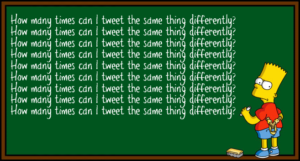Why you should send emails when you’re angry.
“Count to 10.”
“Breathe from your diaphragm.”
“Stick with ‘I’ statements.”
Most advice about anger management comes down to this: Don’t act when you’re angry.
Allow me to offer a contrarian viewpoint: When it comes to email, do act when you’re angry. Received a nastygram? Respond in kind. Hand a mike to that voice inside your head that’s shouting, “What a jerk this guy is!”
Let me explain.
A Lincoln Letter
When you don’t address something that makes your blood boil, you bottle your emotions. Like a ticking bomb, they eventually explode — and usually in a situation far removed from your original grievance.
Instead, try following the practice of a famous bomb technician: President Abraham Lincoln.
As the United States was being torn asunder in a civil war, Lincoln, as commander in chief, often clashed with an insubordinate or incompetent cabinet member or general. His solution was ingenious: He’d compose what he called a “hot letter.” He discovered that the act of writing allowed him to vent his wrath rather than keeping it pent-up.
Then — and this is the key — the Great Emancipator freed himself from the urge to strike back. In other words: He put the missive aside. Hours later or the next day, he’d review what he’d written. More often than not, he’d end up shelving the scolding.
We know this because years after Lincoln’s death, historians discovered a trove of his letters marked with the notation, “Never signed. Never sent.” Old Abe understood what most of us realize only after it’s too late: No good decision has ever emerged when tempers are flaring.
Catharsis
As psychologist Maria Konnikova has observed, the unsent angry letter serves two purposes. First, it provides an emotional catharsis, a way to release your rage without repercussions. Indeed, according to a brain-imaging study conducted by U.C.L.A., verbalizing your thoughts makes your ire less intense.
Second, the unsent letter acts as a strategic catharsis, an exercise in identifying and articulating what you really think. Novelist Flannery O’Connor nailed it when she said, “I write because I don’t know what I think until I read what I say.”
In other words: By putting my feelings into words, I often crystallize my point. Sometimes I even realize that I don’t have one.
3 Strategies
So how do you execute a Lincoln letter? Here are three tactics I use at least once a week:
1. Use Your “Drafts” Folder
Write the email your heart craves. Indulge your indignation. Let loose your sarcasm. Hurl forth your quips. Then, instead of clicking “Send,” tuck the email into your “drafts” folder.
Let an hour pass, then read what you’ve uncorked. Revise as appropriate. Let another hour, or even day, pass, then read and revise again. Repeat until you’re spent or satisfied.
A word to the wise: If you employ this “never signed, never sent” approach, make sure to clear the “To” and “C.C.” fields, lest you accidentally hit “Send.”
2. Send to Yourself
Again, write the email that justice demands, full of fire and fury, then send it to yourself. The mere act of clicking the “Send” button — and then hearing a Pavlovian swoosh sound — can be deeply liberating.
Why? Because clicking conveys finality. It’s like checking a box on your to-do list: This seemingly simple gesture declares that the given task is complete.
A second word to the wise: Delete the message from your inbox, lest it tempt you to reengage.
3. Draft 3 Versions
You know the drill: Write the furious, impassioned email that’s taking shape in your head. This time, however, write another email that’s the exact opposite: Professional and polite. Pretend you’ll have to defend this humble pie to your mother, or that it’ll be published in tomorrow’s Washington Post.
After you’ve written these two contrasting versions, write a third — a happy medium. By this point, you’ll have toyed around with tone and diction such that your mind is sufficiently untroubled that you can now discover the balance that’s best.
Always Respond
What about not responding at all? Doesn’t flat-out ignoring someone send an equally powerful message?
Yes — it absolutely does. The thing is, the temptation to address a nastygram runs deep. If you don’t respond, the angst will prey on your mind. You’ll think about it when you’re showering, when you’re stuck in traffic — or worse, when you could be enjoying life.
When your house is on fire, don’t pretend otherwise. Grab an extinguisher. Only after the flames have cooled should you consider what to do next.
Jonathan Rick teaches business writing at the University of Maryland and delivers workshops on the art and science of email etiquette.
A version of the above article appeared in Thrive Global on November 9, 2020 and in the Washington Examiner on November 27, 2020.



